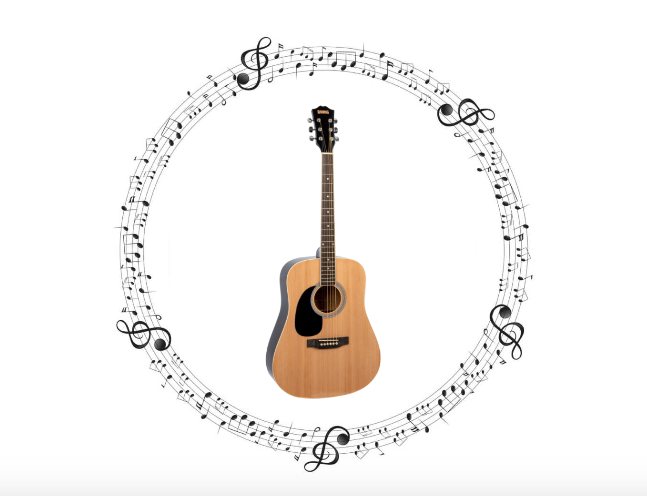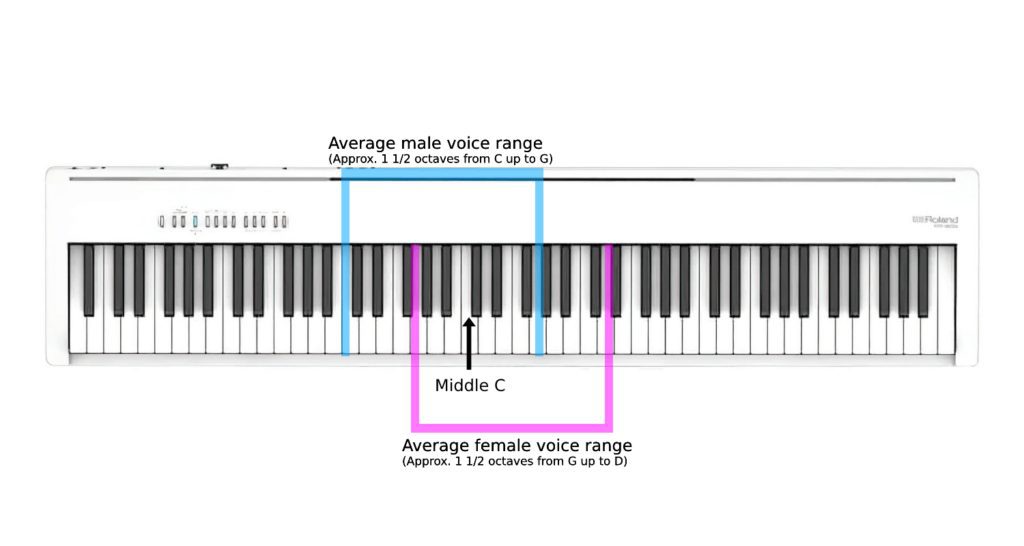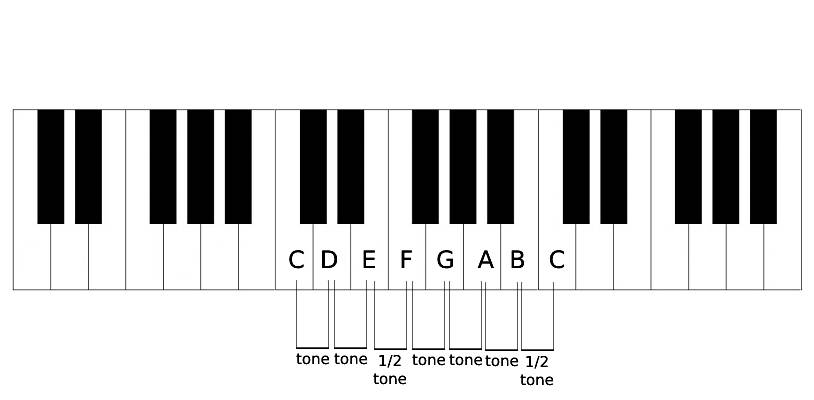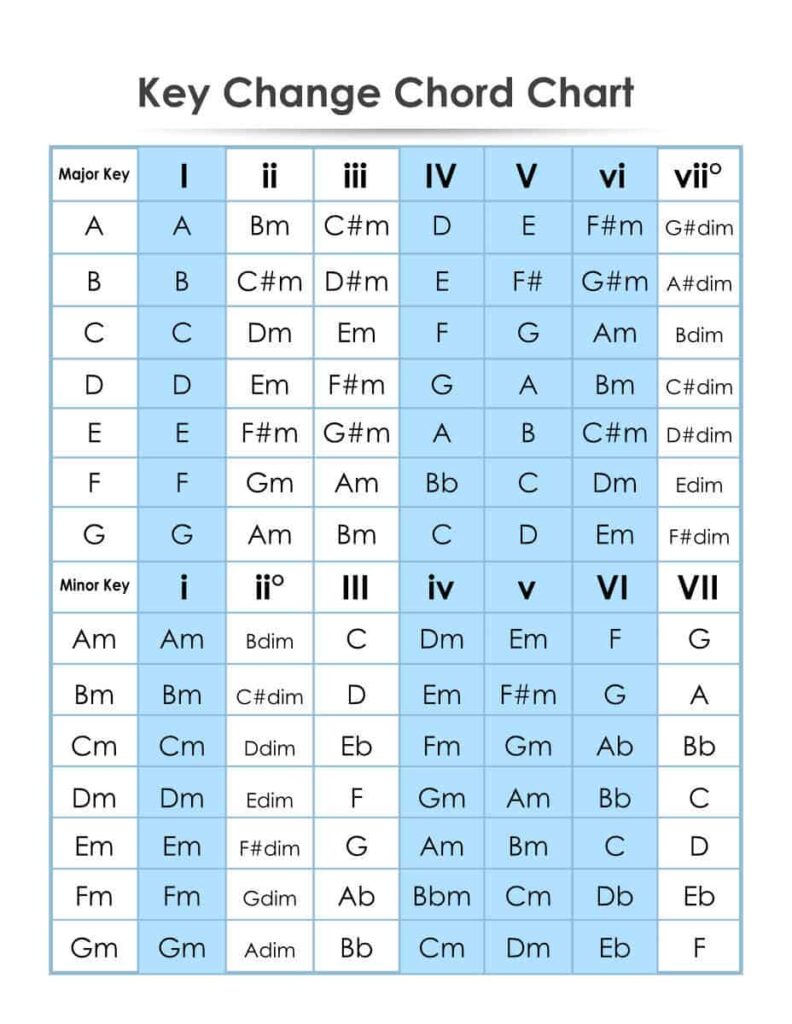Download the free music theory for guitar pdf

The purpose of this article is for guitar players to understand the basics of guitar music theory for beginners. Learning music theory will allow you to understand the concept of keys. This is very important, especially if you plan to sing while you play. It will also allow you to modify a given song’s key in order to use easier chords.
What is a key in music and why is it important?
Many popular songs are written in the key of C, while others are in the Key of G or F and so on. Essentially, there is a key for each note. For ex, there is a key for C, C#, D, D# etc. Keys are made of scales that contain 7 different notes.
Keys are important for singing
Why are keys important for singing? Because each singer has a unique vocal range, meaning they can only comfortably sing a specific range of high and low notes. Each singer’s range varies greatly. An easy example to illustrate this is to think of how men generally sing lower than women.
The image below illustrates the average male voice range (in blue) and the average female voice range in pink. Notice how the average female voice range is higher than the average male voice.

*Exercise: Find a keyboard and experiment with figuring out your vocal range. You’ll know you’ve found the limits of your range when the low or high notes start to sound forced. (this can of course be improved with good singing technique).
Finding the key that works for your voice
To explain why keys are important for singing: Different keys contain sequences of notes that fall within lower or higher ranges. By knowing how to change keys on the guitar, you can adjust the key of a particular song to find the perfect match for your unique vocal range.
Understanding the major scale
To understand keys, you need to understand the major scale. There are many types of scales, but the major scale is the most important and commonly used one, so we’ll start there.
The major scale in the key of C is: C-D-E-F-G-A-B-C (these notes make up the key of C major). On the guitar, it looks like this:

If you play this, you will recognize a familiar scale pattern. What makes this recognizable to the ear is the distance between the notes. On the guitar, each fret is a semitone and every two frets is called a whole tone. So let’s look at the distances between each note of this scale:
Between C-D is a whole tone or T
D-E: whole tone or T
E-F semitone or S
F-G: T
G-A: T
A-B: T
B-C: S
It’s easy to visualize this on the piano because if there’s a black note between two white notes, it means the distance is a tone (T). If there are no black notes, then the distance between the two white notes is a semitone (S) or 1/2 tone. All together we get the pattern T-T-S-T-T-T-S

This T-T-S-T-T-T-S sequence of intervals is common to each major scale, meaning if you take the note G and use the major scale intervals T-T-S-T-T-T-S. You’ll get:
G-A-B-C-D-E-F#-G.
These are the notes of the Key of G.
To the ear, it will seem indistinguishable from the C major scale because it shares the same sequence of intervals. Our perception focuses on the spacing between the notes rather than the actual notes themselves (unless one possesses perfect pitch). For instance, most individuals cannot tell a C note apart from a G note (unless they observe the note being played), but nearly everyone can detect the relationships between notes and identify a major scale or the melody of a song.
How this relates to singing with a guitar?
When learning to sing a song, you might discover that the original key is too high for your comfort. To address this, you can use a capo to adjust the key up or down by a tone and determine how the new range suits your voice.
Alternatively, if the song is in the key of C, you can transpose it to the key of G (more on how to do this later in this article). You may find that the range of notes in the key of G is more suitable for your voice.
Understanding chords
A chord is made up of at least 3 notes
A chord consists of at least three notes played simultaneously. While a chord can include more than three notes, it cannot have fewer. Playing just two notes together forms either a harmony or a power chord, but not a true chord. Additionally, chords are typically constructed in intervals of thirds.
*Don’t be misled by a chord being labeled with a single letter like C. The chord is named after its lowest note, known as the root, even though it consists of three different individual notes (C-E-G).
Chords are built on the major scale
Let’s come back to the C major scale as an example of how chords are built. Here are the notes found in the C major scale.

Now let’s build chords using C major by stacking thirds on each note of the scale. Notice how it looks like a snowman. C = (C-E-G), Dm = (D, F, A), and so on.

The C, F, and G chords are major, while the Dm, Em, and Am chords are minor. What distinguishes major chords from minor chords is the distance between the middle note of the chord (the 3rd) and the bottom note (the root). Major chords use a major third, while minor chords use a minor 3rd.
This sequence of major, minor, and diminished chords is consistent for each major scale. *Don’t worry about diminished chords for now. There is only one per scale and it is not used much in popular music.
Musicians often number the notes of the scale as degrees instead of naming them as letters. This practice helps in identifying corresponding chords across different keys more easily. For example, the V chord in the key of C is G.
Using Roman Numerals
To highlight which chords are minor and major chords, roman numerals are used.
For ex:

I – ii-iii-IV-V-vi-vii
These scale degrees help us easily transpose from one key to another.
To illustrate: If a pop song has the following chord progression
C-Am-F-G
We can quickly figure out the relative chord number for each chord.
They are: I-vi-IV-V in C.
Now if we want to play that song in the Key of G, we know that the new chord progression will be
G-Em-C-D, which is I-vi-IV-V in G.
At this point, you might be thinking, “If there are 12 keys, that’s a lot to remember.” Don’t worry too much, because most popular songs on the guitar or ukulele are played in just two keys: C and G.
Moreover, as you learn more songs, you’ll notice that certain chord progressions are frequently used. Various arrangements of the following chords are common in popular music: I-iv-IV-V.

Real-world guitar music theory example: Let it Be
Let’s take Let It Be and figure out how to change keys with it.
The song starts with this chord progression in C but for this example, we want to try it in the Key of G to see if it fits our voice better.
The chords in the verse are:
C-G-Am-F-C-G-F-C
So the Roman numerals would be:
I-V-vi-IV-I-V-IV-I
Now let’s try that in the key of G.
I = G
V = D
vi = Em
IV = C
So, our Let it Be chord progression in G is now:
G-D-Em-C-G-D-C-G
Play the song in G and see how it suits your voice. Does it feel better in this key or in the key of C?
Change the key further with a capo
Now that the song is in the key of G, you can modify it again using the capo. Move the capo up the neck and test once again how it sounds and feels on your voice.
The combination of transposing keys and using the capo, allows you to find the perfect key. This is a real game changer because once you’ve found the perfect key for your voice, you will sound and feel much better while you sing.
Try it on another song
Now, try this exercise with a song you are interested in. Don’t just settle for the key that someone else has written or the one that worked for the original singer. Experiment and find the key that suits your unique voice best.
Conclusion: Guitar Music Theory for Beginners
Learning a bit of guitar music theory will help you become a better player because you’ll have a greater understanding of the instrument. It will also allow you to transpose the key of a song that you are learning. This may be done to either help you find a better key for your unique vocal range or simply to play the song with chords that you are more comfortable with.
About Musiprof
Musiprof is a Canadian music education website that allows you to connect with qualified guitar teachers near you.
- To find a guitar teacher in Montreal, visit: Guitar lessons Montreal
- If you’re interested in finding a teacher in Vancouver, visit Guitar lessons Vancouver
- Looking for a teacher in Toronto? Visit Guitar lessons Toronto


